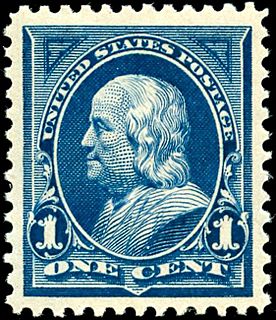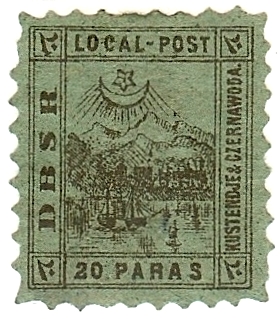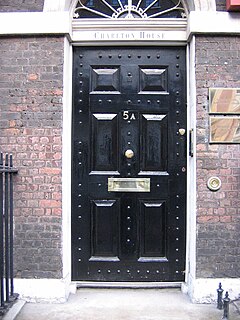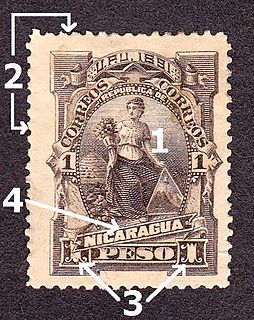
A postmark is a postal marking made on a letter, package, postcard or the like indicating the date and time that the item was delivered into the care of the postal service. Modern postmarks are often applied simultaneously with the cancellation or killer that marks the postage stamp(s) as having been used, and the two terms are often used interchangeably, if incorrectly. Postmarks may be applied by hand or by machines, using methods such as rollers or inkjets, while digital postmarks are a recent innovation. The local post Hawai'i Post had a rubber-stamp postmark, parts of which were hand-painted. At Hideaway Island, Vanuatu, the Underwater Post Office has an embossed postmark.

The United States Postal Service is an independent agency of the executive branch of the United States federal government responsible for providing postal service in the United States, including its insular areas and associated states. It is one of the few government agencies explicitly authorized by the United States Constitution.
Canada Post Corporation, known more simply as Canada Post, is a Crown corporation which functions as the primary postal operator in Canada. Originally known as Royal Mail Canada, rebranding was done to the "Canada Post" name in the late 1960s, even though it had not yet been separated from the government. On October 16, 1981, the Canada Post Corporation Act came into effect. This abolished the Post Office Department and created the present day Crown corporation which provides postal service. The act aimed to set a new direction for the postal service by ensuring the postal service's financial security and independence.

The history of postal service of the United States began with the delivery of stampless letters, whose cost was borne by the receiving person, later also encompassed pre-paid letters carried by private mail carriers and provisional post offices, and culminated in a system of universal prepayment that required all letters to bear nationally issued adhesive postage stamps.
This is a list of philatelic topics.

A postal marking is any kind of annotation applied to a letter by a postal service. The most common types are postmarks and cancellations; almost every letter will have those. Less common types include forwarding addresses, routing annotations, warnings, postage due notices and explanations, such as for damaged or delayed mail and censored or inspected mail. A key part of postal history is the identification of postal markings, their purpose, and period of use.

A local post is a mail service that operates only within a limited geographical area, typically a city or a single transportation route. Historically, some local posts have been operated by governments, while others, known as private local posts have been for-profit companies. Today, many stamp collectors operate hobbyists' local posts, issuing their own postal "stamps" for other collectors but rarely carrying any mail.

Registered mail is a mail service offered by postal services in many countries, which allows the sender proof of mailing via a mailing receipt and, upon request, electronic verification that an article was delivered or that a delivery attempt was made. Depending on the country, additional services may also be available, such as:

A letter box, letterbox, letter plate, letter hole, mail slot or mailbox is a receptacle for receiving incoming mail at a private residence or business. For the opposite purpose of collecting outgoing mail, a post box is generally used instead. Letterboxes or mailboxes use the following primary designs:

Initial United States postage rates were set by Congress as part of the Postal Service Act signed into law by President George Washington on February 20, 1792. The postal rate varied according to "distance zone", the distance a letter was to be carried from the post office where it entered the mail to its final destination. Rates were adopted in 1847 for mail to or from the Pacific Coast and in 1848 for mail sent from one place in the west to another place in the west. There were double and triple rates as a letter's size increased. There were ship fees which were also added. The ship fee, including the ship rate on letters for delivery at the port of entry, were on a per letter basis, rather than weight. The United States issued its first postage stamps in 1847. Before that time, the rates, dates and origin of the letter were written by hand or sometimes in combination with a handstamp device.

The American Letter Mail Company was started by Lysander Spooner in 1844, competing with the presumed legal monopoly of the United States Post Office.

Rural Free Delivery (RFD) is a service which began in the United States in the late 19th century to deliver mail directly to rural farm families. Prior to RFD, individuals living in more remote homesteads had to pick up mail themselves at sometimes distant post offices or pay private carriers for delivery. RFD became a political football, with politicians promising it to voters and using it themselves to reach voters. The proposal to offer free rural delivery was not universally embraced. Private carriers and local shopkeepers feared a loss of business. The United States Post Office Department began experiments with Rural Free Delivery as early as 1890. However, it was not until 1893, when Georgia Congressman Thomas E. Watson pushed through legislation, that the practice was mandated. However, universal implementation was slow; RFD was not adopted generally in the United States Post Office until 1902. The rural delivery service uses a network of rural routes traveled by carriers to deliver and pick up mail to and from roadside mailboxes.

U.S. Special Delivery was a postal service paid for with additional postage for urgent letters and postal packets which are delivered in less time than by standard or first class mail service. Its meaning is different and separate from express mail delivery service. Essentially it meant that a postal packet was delivered from a post office to the addressee immediately once it arrived at the post office responsible for delivering it, rather than waiting for the next regular delivery to the addressee.

The National Rural Letter Carriers' Association (NRLCA) is an American labor union that represents the Rural letter carriers of the United States Postal Service. The purpose of this Association shall be to "improve the methods used by rural letter carriers, to benefit their conditions of labor with the United States Postal Service (USPS), and to promote a fraternal spirit among its members."
Rowan v. Post Office Dept., 397 U.S. 728 (1970), is a case in which the United States Supreme Court ruled that an addressee of postal mail has sole, complete, unfettered and unreviewable discretion to decide whether he or she wishes to receive further material from a particular sender, that the sender does not have a constitutional right to send unwanted material into someone's home. It thus created a quasi-exception to free speech in cases where a person is held as a "captive audience".

Colombia is a country in north-western South America. Colombia is bordered by Venezuela, Brazil, Ecuador, Peru, Panama and the Caribbean Sea and the Pacific Ocean. With a population of over 45 million people, Colombia has the second largest population in South America, after Brazil. The capital is Bogotá.

A mail bag or mailbag is a generic term for a type of bag used for collecting, carrying, categorizing, and classifying different types of postal material, depending on its priority, destination, and method of transport. It is oftentimes used by a post office system in transporting these different grades of mail. The mailbag is carried by some means of transporting like a mail carrier, animal, or a mobile post office. Letters and printed material delivered by mail in the seventeen-hundreds were carried by horse in a saddle bag. There are several different types of mailbags for different purposes (e.g., transporting mail to and from post offices, delivering mail to businesses and homes. These different styles of mailbags depend on its size and purpose. It can range from "a large bag used for transporting mail on a truck, plane, etc." to a simple "postbag" used by a mail carrier to deliver mail.

The U.S. Parcel Post stamps of 1912–13 were the first such stamps issued by the U.S. Post Office Department and consisted of twelve denominations to pay the postage on parcels weighing 16 ounces and more, with each denomination printed in the same color of "carmine-rose". Their border design was similar while each denomination of stamp bore its own distinctive image in the center (vignette). Unlike regular postage items, whose rates were determined by weight in ounces, Parcel Post rates were determined and measured by increments in pounds. The new stamps were soon widely used by industry, farmers and others who lived in rural areas. Partly owing to some confusion involving their usage, their exclusive use as Parcel Post stamps proved short lived, as regular postage stamps were soon allowed to be used to pay parcel postage rates.
















